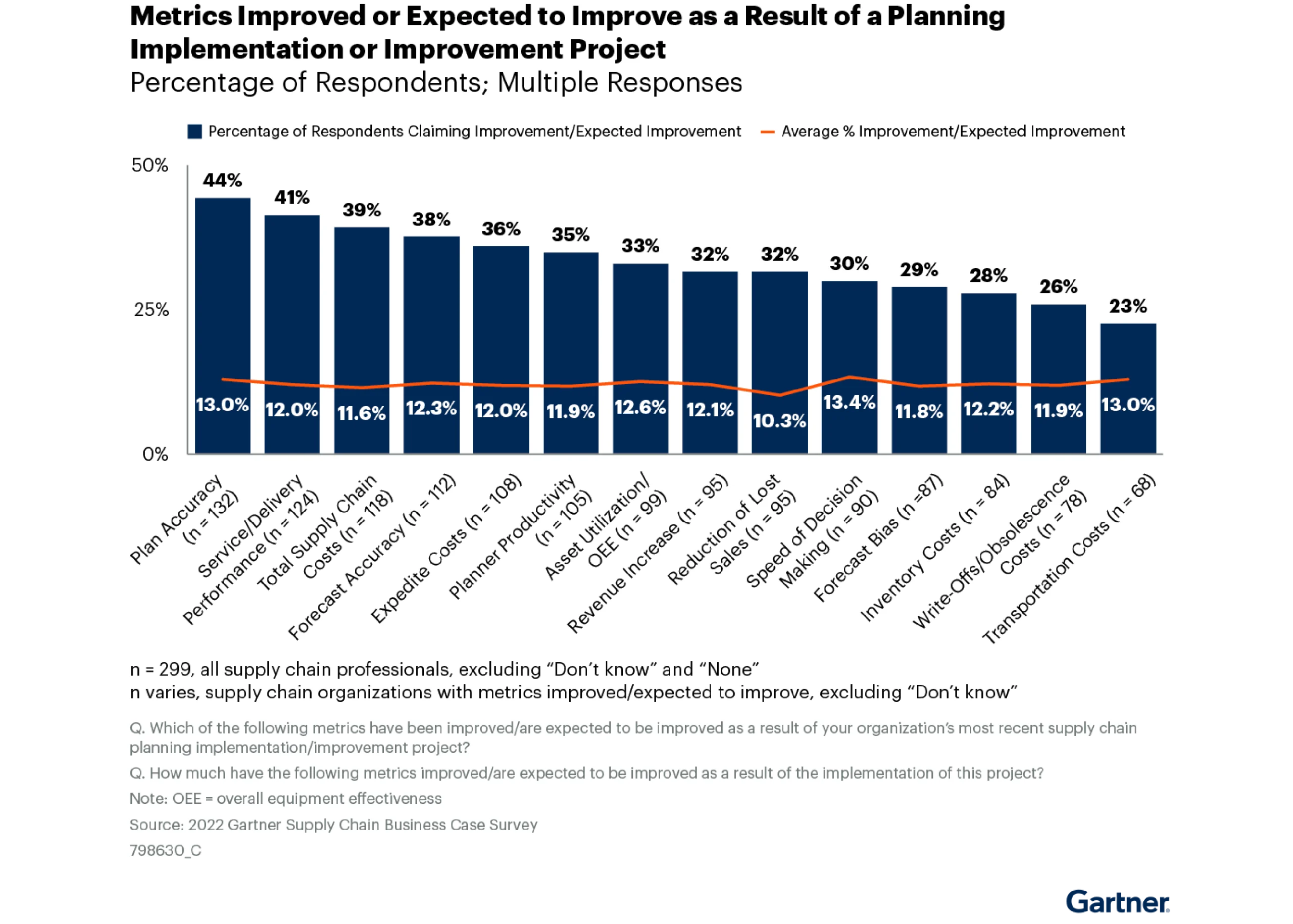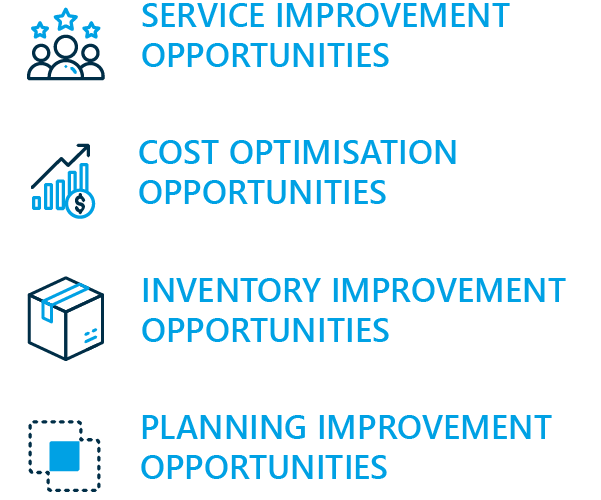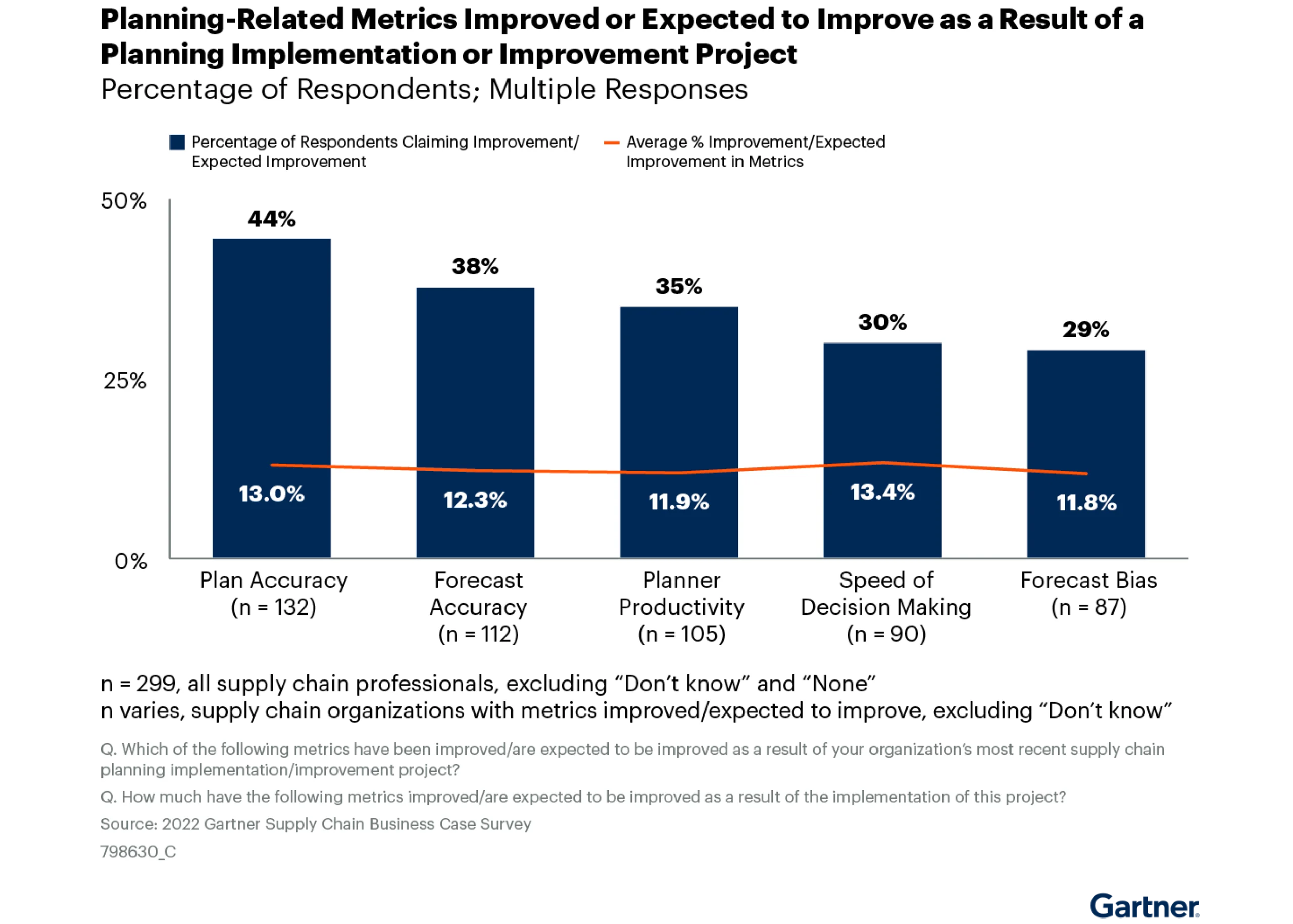S&OP (Sales and Operations Planning) can be a catch-22. You can’t move forward unless everyone pulls in the same direction. But you won’t get everyone on board if you can’t convince them that it’s worth it in the first place.
S&OP is not something you can implement on a whim. It takes time, effort, and commitment from everyone involved. You also require buy-in from top-level management. But make no mistake, the lemon is well worth the squeeze.
Whether you are new to the concept or looking to mature your existing processes, S&OP can deliver uncapped potential to your business. In this article, we will explore how you can begin to quantify the potential value that improving your S&OP maturity can bring to your business, and we will delve into how you can translate the benefits of S&OP into tangible performance improvements throughout your organisation.
S&OP unlocks a world of opportunity
We rave about the benefits of S&OP here at Slimstock. But don’t just take our word for it. As you can see from the diagram below (courtesy of Gartner), the benefits of S&OP are far-ranging:
- Improved accuracy
- Enhanced customer experience
- Optimised supply chain costs
- Elevated productivity
- Reduced lost opportunity
Not only are the potential business gains extensive, but they can be dramatic for companies that throw themselves in with the necessary enthusiasm. For the purposes of this article, we will focus on how elevating your S&OP process can unlock new opportunities for enhancing service levels, optimising supply chain costs, improving inventory quality and enhancing supply chain agility.
Understand the battlefield
Before we dive into the potential for improvement, a word of warning: every business is unique; therefore, the results you can expect from your S&OP improvement initiative hinge on the specific nuances of your organisation.
Your S&OP potential will depend on your starting point. If your business already has an established S&OP process, it’s a great foundation to start from. But, if you’re hoping S&OP will paper over the cracks of poor commercial or supply chain strategy and instantly fix a stalling business, it’s unlikely to do so.
Ultimately, your success and potential for improvement depends on your current level of S&OP maturity, your focus, and the goals driving your S&OP project. Let’s explore this further.
What’s your current level of maturity and your readiness to improve?
If you’re at the beginning of your S&OP journey, it’s likely you’ll see greater improvement across the board. Simply because S&OP likely presents revolutionary change for your organisation. That’s not to say that you cannot leverage further improvement if you already have an S&OP process in place.
But are you ready to take the next leap? To help you explore your current standing point and your capacity to take on the next stage of your S&OP journey, we have put together a handy S&OP readiness checklist.
What’s the focus of your S&OP project?
Your scope for improvement also hangs on what you want to improve. Do you need to fine-tune part of your planning process, or does your approach to supply chain management need a total overhaul?
Significant changes can often lead to big results. But let’s recognise the hurdles that must be overcome to ensure these changes are rolled out successfully. Likewise, small but focused initiatives often pave the way to a better overall performance. The point here is to set realistic expectations and milestones so that you can track progress.
What are the goals for your strategy?
Are you trying to reduce your working capital investment in inventory? Are you trying to bring down costs? Are your service levels the main target of improvement? Knowing the answers to these questions will differentiate your strategy in S&OP and translate it from a cookie-cutter approach into your specific requirements.
Build a business case for S&OP
There are lots of ways S&OP can unlock new opportunities for your business. But, for now, let’s keep things simple. The image below shows the steps to capture the value from implementing or strengthening your S&OP.
Service improvement opportunities: Reap the rewards of enhanced customer experience
According to a recent study by Gartner, most businesses would expect service or delivery performance to improve due to supply chain planning improvement; 41% of companies surveyed said it had improved or was expected to.
How many of your service issues can be attributed to planning errors? How many of them are related to poor sales forecast accuracy? Unless you are actively investigating these issues, the chances are you have no fundamental understanding of how they impact customer experience, and maybe that’s why they occurred in the first place.
Likewise, what impact do service issues have on your profitability? How much are you losing from missed or incomplete orders? And what would that bring to the business if they were rectified?
In the same survey, 32% of those responding said reduction of lost sales or increased revenue were benefits of their implementation.
Improving your S&OP will help you to identify how much lost opportunity could be left on the table.
Cost improvement opportunities: Translate cost savings into improved profitability
S&OP process improvements can reduce your total supply chain costs across the business. This is due to several reasons. Below, we look at some of the specific areas that might arise.
By facilitating discussion around demand and supply and how these two factors influence the broader business goals, S&OP can be a catalyst to rebalance your inventory to achieve an improved service level with less stock.
Of course, the benefits of reducing stock include reduced warehouse costs, reduced write-offs and reduced cost of capital. But the opportunity for cost savings does not end there.
S&OP facilitates more intelligent decision making. For example, should you foot the bill for costly expedited transport? Should you rethink your supplier agreements or use an alternative supplier? Can you do more to increase asset utilisation?
You’ll already know how vital profitability and cost reduction are to your shareholders or stakeholders. It’s likely mentioned in most board meetings. Improving your S&OP better positions you to understand where you can pull levers to cut costs, while still achieving your business goals.
Inventory improvement opportunities: Work your investment in stock harder
Almost a third of those surveyed by Gartner said reducing inventory, or optimising it, was one of their top three objectives.
If that’s a goal of yours, here are some of examples of how elevating your S&OP can deliver on this ambition:
- Creating a single, unified vision of demand
- Enabling higher cross-functional alignment
1. Creating a single, unified vision of demand
To maximise your return on investment in stock, you need a clear picture of demand. An effective S&OP process will support the development of more robust demand plans by engaging the relevant departments to reach a consensus on anticipated demand.
As a result, the whole business benefits from a unified picture of demand, combining statistical forecasting techniques with market intelligence and challenging the output in an open forum. From this, you can optimise your stock investment to focus on the most important products.
2. Higher cross-functional alignment
Different departments have different goals. This is the worst-kept secret in any business. And, as anyone in the supply chain team knows, these goals often conflict.
The issue is that the departments in your business need to have different goals. To achieve great results, the aims of finance team members will naturally differ from those working in purchasing or, frankly, in any other department.
Sales want sales … at any cost. Marketing wants a bigger budget. The warehouse team wants more space and more peace. And your operations team just want to do less firefighting.
Involving everyone in the same decision-making process will improve your entire business. Levelling up your S&OP process will result in fewer crossed wires and nasty surprises. And that must surely be better for everyone.
Planning improvement opportunities: Create flexibility and agility
Reducing costs and improving departmental alignment are essential. But you also need to be able to anticipate, adapt and pivot around disruption. It’s no surprise then that Gartner found that improving forecasting accuracy and speed of decision making are critical outputs of an improved planning process.
What this means for your business will depend on where the opportunities to improve are most keenly felt. Many companies will see better accuracy in their supply plans, higher productivity in planning and quicker decision making.
Every business should try to improve the accuracy of their forecasting. But is improving forecasting enough?
By utilising S&OP, you should be able to create a more definitive and achievable plan. But what happens when we encounter the next ‘black-swan’ event?
You already know you’ll improve collaboration across the business. Every team and department will have a voice and an insight into the company’s north star metrics.
Not only this but the quicker and more seamlessly you can spot risks and opportunities, the better you can scenario plan to limit the impact of those risks and better realise opportunities. This also means that they’ll know what might impact supply and demand, and they’ll be able to assist in building a plan to navigate volatility in whatever form it takes.
Final thoughts on calculating the overall improvement opportunity
Implementing and enhancing Sales and Operations Planning (S&OP) may seem challenging, requiring concerted effort, commitment and alignment from all stakeholders. However, the undeniable truth is that the benefits far outweigh the challenges. S&OP catalyses transformative change within organisations, unlocking many opportunities that can propel businesses to new heights.
As highlighted by Gartner, the potential gains from improving planning processes are extensive, ranging from improved accuracy and enhanced customer experience to optimised supply chain costs, elevated productivity, and reduced lost opportunities. When fully realised, these benefits can lead to dramatic improvements for companies who are willing to embrace the necessary enthusiasm.
In essence, S&OP is not just a process; it’s a transformative journey that positions businesses to anticipate, adapt and thrive in an ever-evolving market.
By leveraging the potential value of S&OP, companies can enhance their operational efficiency and create a competitive advantage that propels them towards sustained success.
As you embark on your S&OP journey, remember that the lemon is indeed well worth the squeeze.
FAQs
What are the key benefits of S&OP?
Sales and Operations Planning (S&OP) provides organisations with improved demand forecasting, inventory optimisation, and enhanced collaboration between all business teams, ultimately leading to better decision making, resource utilisation and customer satisfaction.
How can elevating S&OP processes unlock opportunities for businesses?
Elevating S&OP processes can unlock opportunities for businesses by fostering better alignment throughout the business, enhancing agility in responding to market changes, and optimising resource allocation, ultimately leading to improvements in efficiency, customer satisfaction and overall business performance.
What is the significance of having a clear focus in an S&OP project?
Having a clear focus in an S&OP project is crucial as it ensures streamlined communication, efficient resource allocation and alignment of organisational goals, leading to a more successful implementation and improved overall performance.
What role does top-level management play in the success of S&OP implementation?
Top-level management plays a pivotal role in the success of S&OP implementation by providing strategic direction, allocating necessary resources, and fostering a culture of collaboration and accountability, all of which are essential elements for the effective execution of sales and operations planning within an organisation.
How does S&OP contribute to enhanced customer experience and improved service delivery?
S&OP contributes to enhanced customer experience and improved service delivery by ensuring better inventory management, accurate demand forecasting and efficient resource allocation, allowing businesses to meet customer expectations with timely and reliable products or services.









